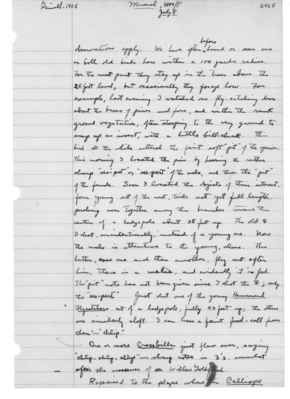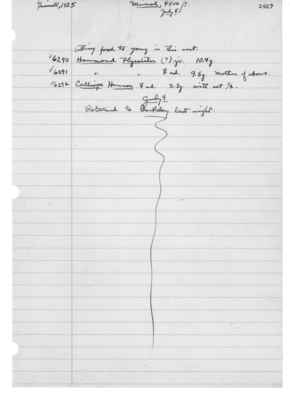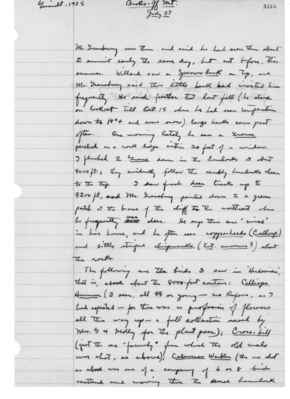Pages That Mention Calliope Hummingbird
1925: Joseph Grinnell's field notes
S2 Page 61
Collector: Grinnell - 1925 Location: Mineral, 4800 ft. Date: July 2 Page Number: 2514
was just building, tho [sic] the nest seemed nearly ready for eggs. I climbed up and by string found the rim of the nest to be very close to 30 feet above the ground. It rested upon a party disintegrated cone, like scores of others on the old branches all about. This particular half-cone was attached to a twig which was grown off directly beneath a larger limb (1 1/2 in diam.). The nest was out 3 feet from the main bole of the tree, at that point about 10 inches in diameter. The nest was thus [illustration of tree] well sheltered from directly above. [illustration of tree continued] This find indicates what I suspected, namely, that the female Calliope Hummers are nesting rather remotely from the trysting places where the males have their "stands."
A further find was the nest of Hammond Flycatcher; [female symbol] shot, but nest not as yet reached. Found by watching the two birds, Mrs. G. one and I the other. These we had located by hearing the rather weak "see-put" note. My bird finally led me to the nest, about 25 feet up, near the forking end of a long out-swaying branch, fully 8 feet from the trunk (lodgepole). The bird alighted on the edge of the nest appeared to feed, whether a mate or young birds I could not tell. Later a bird coming to the nest was shot and proved to be the [female symbol] with glandular breast. The site of this nest, as with Hoffmann's (p. 2490), is thus totally
S2 Page 72
Collector: Grinnell - 1925 Location: Mineral, 4800 ft. Date: July 8 Page Number: 2525
observation apply. We have often ^before head or seen one or both old birds here within a 100 yards radius. For the most part they stay up in the trees above the 25-foot level, but occasionally they forage. For example, last evening I watched one fly-catching down about the bases of pines and firs, and within the rank ground vegetation, often stooping to the very ground to snap up an insect, with a little bill-click. This bird all the while uttered the faint soft "pit" of the species. this morning I located the pair by hearing the rather sharp "see-put" or "see-pert" of the male, and then the "pit" of the female. Soon I located the objects of their interest, four young out of the nest, tails not yet full length, perching near together among the branches toward the center of a lodgepole about 25 feet up. The old [female symbol] I shot, unintentionally, instead of a young one. The latter, now one and then the other, fly out after him, there is a melee, and evidently it is fed. The "pit" note has not been given since I shot the [female symbol], only the "see-pert." Just shot one of the young Hammond Flycatchers out of a lodgepole, fully 40 feet up; the others are similarly aloft. I can heard a faint food-call from them - "chlip."
One or more Crossbills just flew over, saying "chup - chup - chup" - sharp notes in 3's, somewhat after the manner of a Willow Goldfinch.
Repaired to the place where the Calliope
S2 Page 73
Collector: Grinnell - 1925 Location: Mineral, 4800 ft Date: July 8 Page Number: 2526
Hummingbird's nest was found July 2 (p. 2513). With glasses saw the bird siting; then I climbed. Set 1/2 and nest taken. Female shot after I came down, as she buzzed about the vacant site. She had left the nest, when I had gotten within 4 feet below her.
Sierra Junco's nest with five eggs taken: ^[incubation advanced] completely sheltered from above under awning found by broken-off end of 8 inch log overgrown by tall grass and herbage. Nest, taken, well above ^(45 mm. to rim) level of surrounding sod; in fact, nothing on ground, not in hollow, as is often the case: [illustration of nest and log] Grass grows up all about it: [illustration of nest and log continued]. Bird flushed only when I happened to put my foot down scarcely ten inches from her. In meadow, in partial shadow of numbers of smallish lodgepole pines in a tract.
Mountain Chickadee's nest with 5 half-grown young; in ^small burnt stub standing in edge of meadow; cavity apparently natural, rotted out, inside a vertical split, 25 mm., at widest; lower edge at bottom of split, 1580 mm. (only) above ground; nest-cavity inside about 175 mm. lower. Looking down in through the entrance crevice, one could see in the darkness only the five yellow bill-edges (corners of the mouth chiefly), shining forth.
Wood Pewee's nest, saddled in forking of live lodgepole pine limb about 30 feet above the ground; limb extending south, out over meadow. Adults seen
S2 Page 74
Collector: Grinnell - 1925 Location: Mineral, 4800 ft. Date: July 8 Page Number: 2527
Taking food to young in this nest.
6290 Hammond Flycatcher (?) ju. 10.4g. 6291 [Hammond] [Flycatcher] [female symbol] ad. 9.5g. Mother of above. 6292 Calliope Hummer [female symbol] ad. 2.3g. with set 1/2.
S2 Page 79
Collector: Grinnell - 1925 Location: Broke-off Mt. Date: July 27 Page Number: 2532
Mr. Gransbury saw them and said he had seen them about the summit early the same day, but not before, this summer. Willard saw a Sparrow Hawk on top, and Mr. Gransbury said this little hawk had visited him frequently. He said further that the last fall (he staid on lookout till Oct. 15 when he had seen temperatures down to 14°+ and some snow) large hawks came past often. One morning lately he saw a Grouse perched on a rock ledge within 20 feet of a window. I flushed 2 Grouse down in the hemlock at about 9000 ft.; they evidently follow the scrubby hemlocks cleans to the top. I saw fresh deer tracks up to 9200 ft., and Mr. Gransbury pointed down to a green patch at the base of the cliff to the northeast where he frequently sawsees deer.He says there are "mice" in his house and he often sees copperheads (Callosp.) and little striped chipmunks (Eut. amoenus?) about the rocks. The following are the birds I saw in "Hudsonian" that is, about the 8000-foot contour: Calliope Hummer (3 seen, all [female symbol] [female symbol] or young - no Rufous, as I had expected - for there was a profusion of flowers all the way up - a full collection saved by Mrs. G. & Molly for the plant press); Cross-bill (just the one "family" from which the old male was shot, as above); Calaveras Warbler (the one shot as above was one of a company of 6 or 8 birds scattered and moving thru [sic] the dense hemlock




